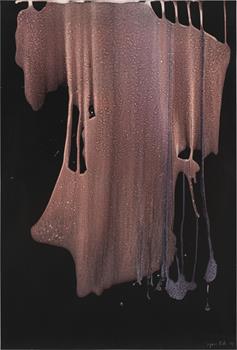0052
Sigmar Polke*
(Oels/Niederschlesien 1941 - 2010 Köln)
„Untitled“
1999
mixed media on paper; framed
101 x 68 cm (sheet size)
signed and dated on the lower right: Sigmar Polke 99
Provenance
private property, Austria
Estimate: € 50.000 - 100.000
Auction is closed.
Sigmar Polke is one of the most important contemporary German artists and is known for his experimental approach to painting, whereby he liked exploring the boundaries of medium and material and challenging established notions of the role and meaning of art. His diverse oeuvre, often infused with ironic humour, is difficult to categorise as belonging to any particular style or genre: Polke’s activities encompassed photography, filmmaking, printmaking, drawing, sculpture and performance art. However, he engaged most intensively with aesthetic questions and traditions in painting. His interest in alchemy also led him to conduct investigations into the optical effects of pigments and minerals in paint. A fascination with the significance of chance was also a particularly important element in Polke’s work.
Particularly from the 1980s onwards, his interest in “Schütt- und Lackbilder” (“poured and lacquered paintings”) was focused on the medium of colour. In predominantly large-format works on paper, which occupied the artist over a period of about 15 years, a constant dialogue between order and chaos, chance and control came into being, with Polke experimenting with a wide variety of substances and alchemical processes. Usually on black background, he let streams of opalescent paint – poured, sloshed or sprayed – flow across the picture surface in autonomous rivulets. Enhanced by the addition of powdered pigment, mica and other materials suspended in the viscous paint, Polke created illusions of shifting light and space, the perception of which changed depending on the viewer’s position in relation to the surface of the picture. This produced aesthetically pleasing, meandering bands of colour that were per se random and autonomous, yet always controlled by their creator. Although essentially abstract, they evoke familiar images of clouds, wafts of mist or other otherworldly things in the eye of the beholder and reveal Polke’s fascination with the creative process and its relationship with chance and effect.
(Ina Waldstein)


